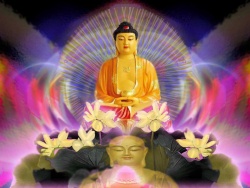Right concentration
Right concentration (sammā samādhi) is the eighth step on the Buddha’s Noble Eightfold Path and is an essential component of successful meditation.
It is defined in the scriptures as ‘any unification of the mind’ (M.I,301) and is sometimes also called ‘one-pointedness of mind’ (ekodibhāva). The advantages of concentration are many.
The attention is fixed on an object for a sustained period allowing us to come to know it better and thus it has a role to play in wisdom.
When we have developed concentration, we can turn our attention to whatever we like, rather than having it constantly flitting from one thing to another as is usually the case.
The ability to do this can minimize useless daydreaming, worry and unwanted intrusive thoughts thus giving us a degree of peace and calm.
In Buddhist meditation, concentration is usually developed by practicing mindfulness of breathing (M.III,82).
According to the Buddha there are several things we can do which will assist in the development of concentration.
The first is following the Precepts. Doing this simplifies our life and minimizes the possibilities of remorse, embarrassment and conflicts with others, all of which keep the mind churned up.
Another thing is what the Buddha called guarding the sense doors (indriya saṃvara), which means not seeking out situations that will over-stimulate the mind (D.I,70).
Also, there is a direct connection between physical ease, psychological well-being and concentration.
While actually practicing meditation, maintaining a relaxed, comfortable posture will allow the body to become still without being forced. Likewise, having a light, joyful attitude will make concentration easier.
The Buddha said that ‘... from gladness comes joy, being joyful the body is tranquil, with a tranquil body one is happy, and the mind that is happy becomes concentrated’ (D.I,74).
Right concentration (samyak-samādhi / sammā-samādhi), as its Sanskrit and Pali names indicate, is the practice of concentration (samadhi).
It is also known as right meditation.
As such, the practitioner concentrates on an object of attention until reaching full concentration and a state of meditative absorption (jhana).
Traditionally, the practice of samadhi can be developed through mindfulness of breathing (anapanasati), through visual objects (kasina),
and through repetition of phrases (mantra). Samadhi is used to suppress the five hindrances in order to enter into jhana.
Jhana is an instrument used for developing wisdom by cultivating insight and using it to examine true nature of phenomena with direct cognition.
This leads to cutting off the defilements, realizing the dhamma and, finally, self-awakening.
During the practice of right concentration, the practitioner will need to investigate and verify their right view.
In the process right knowledge will arise, followed by right liberation.
In the Pali Canon, it is explained thus:
And what is right concentration?
(i) Herein a monk aloof from sense desires, aloof from unwholesome thoughts, attains to and abides in the first meditative absorption jhana,
which is detachment-born and accompanied by applied thought, sustained thought, joy, and bliss.
(ii) By allaying applied and sustained thought he attains to, and abides in the second jhana, which is inner tranquillity, which is unification (of the mind),
devoid of applied and sustained thought, and which has joy and bliss.
(iii) By detachment from joy he dwells in equanimity, mindful, and with clear comprehension and enjoys bliss in body, and attains to and abides in the third jhana,
which the noble ones (ariyas) call "dwelling in equanimity, mindfulness, and bliss".
(iv) By giving up of bliss and suffering, by the disappearance already of joy and sorrow, he attains to,
and abides in the fourth jhana, which is neither suffering nor bliss, and which is the purity of equanimity — mindfulness.
This is called right concentration.
Although this instruction is given to the male monastic order, it is also meant for the female monastic order and can be practiced by lay followers from both genders.
According to the Pali and Chinese canon, right concentration is dependent on the development of preceding path factors:
The Blessed One said: "Now what, monks, is noble right concentration with its supports and requisite conditions?
Any singleness of mind equipped with these seven factors —
right view,
right resolve,
right speech,
right action,
right livelihood,
right effort, and
right mindfulness
is called noble right concentration with its supports and requisite conditions.
—Maha-cattarisaka Sutta
Tranquillity and Insight, A.Sole-Leris, 1992. </poem>





